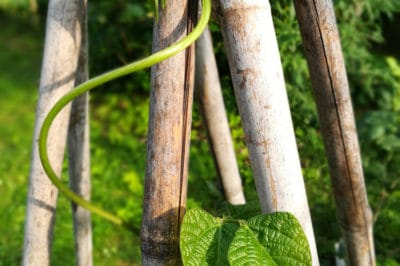Safety First
If you plan to use your teepee for children (especially smaller children), make sure the beans are edible. Hyacinth beans, for example, are ornamental but can be toxic. The supports should be sturdy enough to support a heavy bean vine; sink them into the soil to stabilize the teepee. Make sure the opening is big enough for children to move freely.
Choosing Beans
Any type of pole bean will work for a bean tower. In addition to the classic snap or string bean that most people consider a “green” bean, try:
- Scarlet runner beans – the brilliant flowers attract hummingbirds and the beans are edible.
- Yardlong beans – also called asparagus beans, some have bright red 30-inch bean pods.
- Winged beans – the beans have an unusual shape and lacy tendrils for extra eye appeal.
Choosing Materials
Many different kinds of materials make good green bean teepees. Wooden dowels, aluminum poles and bamboo poles are available from garden centers and hardware stores. Bamboo poles in particular are a classic material for teepees. If you or a neighbor trim back trees or have a woodlot, you can usually find saplings or tree trimmings.
Soil Preparation
Pole beans need fertile soil – they have a lot of leaf canopy to support – not to mention the flowers and pods. However, too much nitrogen will favor leaf growth at the expense of beans. Work in an organic 5-10-10 fertilizer and add humus with well-rotted leaf mold, aged manure or organic compost. You can add additional height to the teepee by building up a circular soil mound – plant edible nasturtiums as companions.
Make It Big Enough
If you just want some green beans, any size will work. For a kid’s playhouse, however, your poles should ideally be about eight feet tall; most children can stand easily in that size. The base of the circle should have a diameter of at least four feet; plenty of room for two kids. Extra poles make for thicker “walls.”
Fasten Securely
Making sure the pole tops are well-fastened will prevent the whole structure from coming down. Several commercial devices are available to secure the poles – most are designed for dowels or bamboo poles. You can also lash poles together with heavy string, twine or wire. It will be easier if you find a helper so you can get up on a ladder and fasten the poles together at the top.
